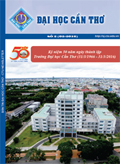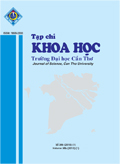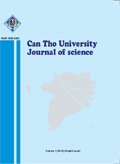Pre-treating anthocyanin-rich black cane with ferrous sulfate heptahydrate
(FSH) produces high-quality silage with anthocyanin and nutritional losses.
However, it’s unclear how to apply this to studies on how FSH-treated silage
aects animal performance and meat quality. Therefore, this study aimed
to investigate the eects of a standard total mixed ration (TMR) containing
anthocyanin-rich black cane silages either with or without dilutions of FSH
on animal performance, blood biochemical indices, rumen fermentation,
microbial community, and carcass characteristics in meat goats. Forty healthy
crossbred Thai-native Anglo-Nubian male goats (14.42 ± 1.4 kg) were used
to compare the feasibility of using anthocyanin-rich black cane silage (ABS)
as a functional feed resource as opposed to anthocyanin-rich black cane
treated with 0.030% commercial FSH silage (ABSF). All goats received a
90-day routine feeding of two isocaloric and isonitrogenous experimental
diets: the control group received TMR containing 50% anthocyanin-rich black
cane silage (ABS; n = 20), and one group received TMR containing 50%
FSH-treating anthocyanin-rich black cane (ABSF; n = 20). As performance
indicators, average daily weight gain (ADG) and dry matter intake (DMI)
were measured. Samples of meat, blood, and rumen were taken at the end
of the experiment. There were no dierences in final body weight, ADG,
DMI, or ADG/DMI between the two groups. The ABSF group did not dier
from the ABS group in terms of rumen pH, but the ABSF had a tendency
to lower rumen ammonia N levels, and to higher total volatile fatty acid
(VFA) concentrations. Individual VFA concentrations diered, with the ABSF
group having more Ruminococcus albus and the ABS group having more
methanogenic bacteria. Blood biochemical indices diered, with the ABSF
group having lower TBARS concentrations and the ABS group having lower
TAC, SOD, CAT, GSH-Px, and GSH-Rx concentrations. In comparison to goat
meat from the ABS group, goat meat from the ABSF group contained more
intramuscular fat and was more tender. The current results indicate that the
feeding of a TMR containing 50% anthocyanin-rich black cane, along with
FSH pre-treatment prior to ensiling, reduces oxidative stress and promotes the
production of tender meat without aecting animal performance.
KEYWORDS
anthocyanin, antioxidant capacity, agricultural waste, carcass characteristics,
fermentation, microbial rumen, iron-treated silage






